Key takeaways:
- Unusual venue layouts, such as circular or outdoor spaces, enhance creativity and collaboration by fostering open dialogue and equality among participants.
- Unique venues can create memorable experiences and encourage networking in relaxed settings, but they also present challenges like acoustics and guest navigation.
- Effective management of unconventional spaces involves clear communication, adaptable logistics, and transforming challenges into networking opportunities.

Understanding unusual venue layouts
When I first encountered an unusual venue layout, I was taken aback. A modern art gallery transformed into a corporate space was a memorable experience. The irregular shapes of the walls and the placement of the art challenged our traditional notions of meeting spaces. Have you ever wondered how such a layout can actually enhance creativity and collaboration? I found that the unconventional design sparked conversations and fostered a dynamic environment that a standard boardroom could never achieve.
One layout that surprised me was a circular space void of corners, designed for discussions rather than presentations. It changed the way we interacted—everyone felt equally involved. I often think about how much wiser I have become since that event. It made me realize that non-traditional setups can break down barriers and encourage open dialogue among participants. Have you experienced something similar?
Exploring these unique layouts has taught me the importance of adaptability in event planning. I learned to embrace spaces that challenge the norm, realizing they often inspire innovation. Isn’t it fascinating to think about how the physical space can shape our experiences and interactions? Each unusual layout presents an opportunity to rethink engagement and connection in ways we hadn’t considered before.
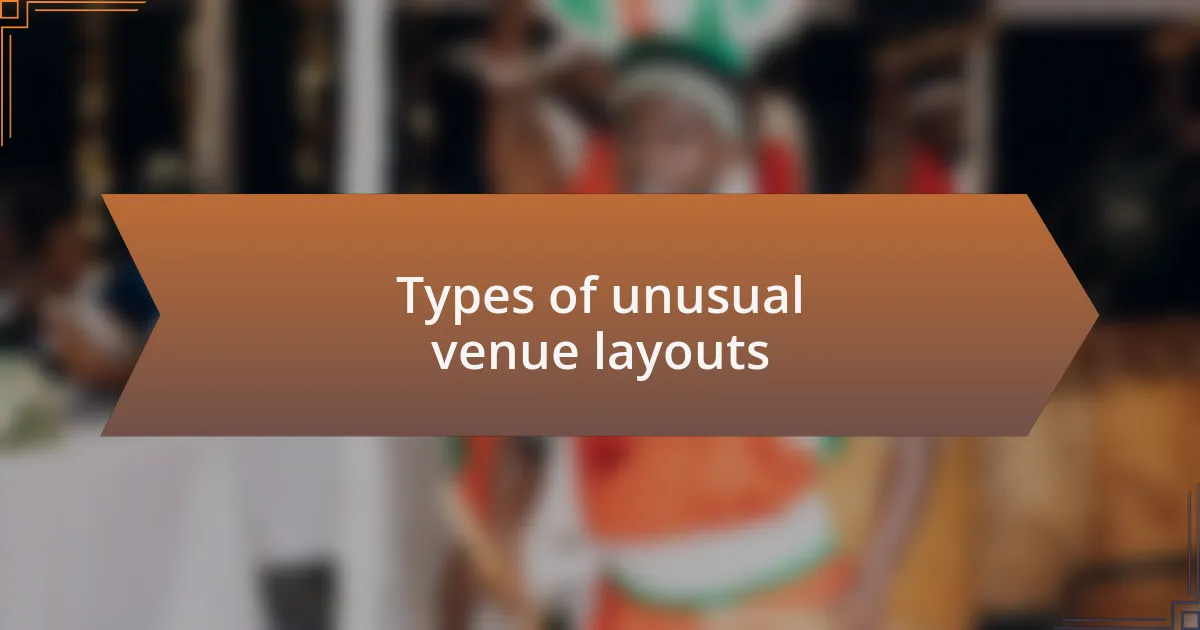
Types of unusual venue layouts
When I think about unusual venue layouts, I can’t help but recall a square room reimagined into a multi-level setting complete with platforms. It allowed for a variety of engagement styles—some participants sat beneath, while others stood above, creating different perspectives on discussions. Have you ever noticed how shifting physical levels can change the way we perceive conversations? It certainly revitalized the energy in the room, and I felt a thrilling connection to my surroundings that I often miss in more traditional spaces.
Another intriguing layout I encountered was an outdoor garden that doubled as a conference venue. The open-air setting, surrounded by flowers and trees, unexpectedly brought a sense of tranquility that I had never experienced in a formal event. I remember a moment when the breeze swept through, making it feel less like a meeting and more like a gathering of friends. It made me ponder—can the soothing sounds of nature enhance productivity? I truly believe that environments like these can foster creativity and collaboration in surprising ways.
One particularly memorable layout was an old warehouse with an industrial vibe, where we set up various breakout areas scattered throughout the space. The eclectic mix of furniture and the raw decor gave participants the freedom to roam and connect informally. I noticed how people gravitated toward spaces that felt cozy or intriguing, prompting discussions that sparked innovation. It left me wondering—how often do we overlook the potential of a non-traditional layout to inspire new ideas? This experience taught me that sometimes, the most unconventional settings can lead to the most rewarding interactions.
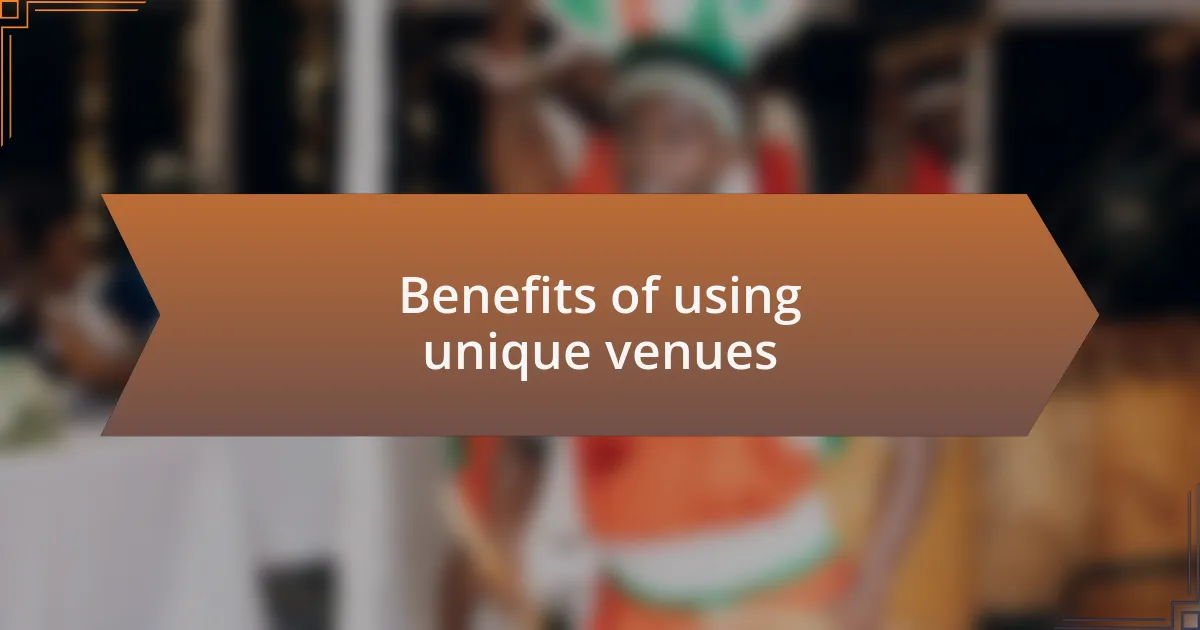
Benefits of using unique venues
Choosing unique venues for events can lead to unforgettable experiences. I remember managing a corporate retreat at an art gallery, where the vibrant artwork sparked creativity and conversation among attendees. Having such unexpected surroundings prompted participants to think outside the box. Isn’t it fascinating how the right environment can shift mindsets?
Another time, I organized a seminar in a historic library, complete with towering shelves of books. The atmosphere was rich with history and inspiration. I felt an immediate connection to the weight of knowledge in the room, which encouraged deep conversations. How often do we find ourselves inspired simply by our surroundings?
Unique venues can also promote networking in unexpected ways. At one event in a cozy, themed café, I witnessed connections being made over shared interests in a relaxed setting. The soft ambiance allowed for genuine interactions. Don’t you find that sometimes, informal settings can lead to stronger professional relationships? In my experience, these moments often become the highlight of the event.
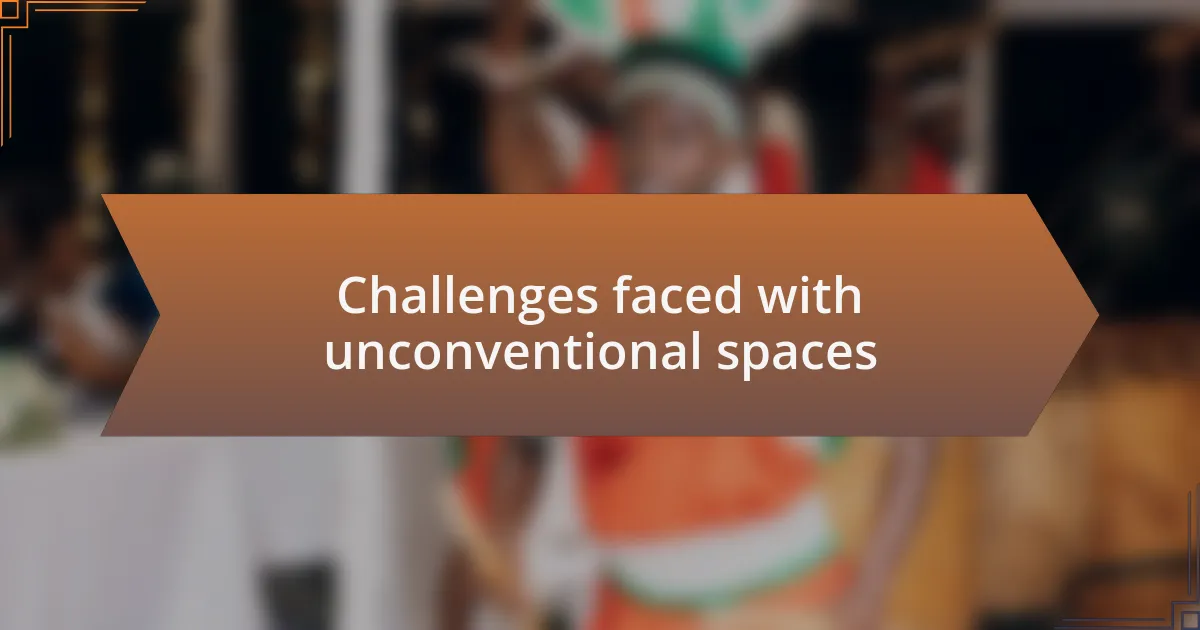
Challenges faced with unconventional spaces
When working with unconventional spaces, one significant challenge I’ve encountered is understanding the limitations of the layout. I once managed an event in a converted warehouse where the high ceilings and open floor plan seemed inviting, but it quickly became apparent that sound carried poorly across the venue. How often do we overlook acoustics, thinking the charm of a space outweighs its functional drawbacks?
Logistics often turn into a puzzle in these unique venues. During a wedding at a botanical garden, we faced the challenge of organizing a catering setup in areas far removed from the kitchen. I watched as our team had to navigate narrow paths with heavy equipment. It’s moments like these that test our resourcefulness—how do we adapt on the fly to keep everything running smoothly while adhering to the space’s character?
Another hurdle is guest comfort. At a recent outdoor festival, the unorthodox layout encouraged exciting exploration but also led to confusion about where to find essential services. I saw guests wandering aimlessly, and it struck me how critical clear signage and guidance is in such layouts. So, how do we balance the charm of a distinctive venue with the practical needs of our attendees? It’s a question worth pondering as we design these immersive experiences.
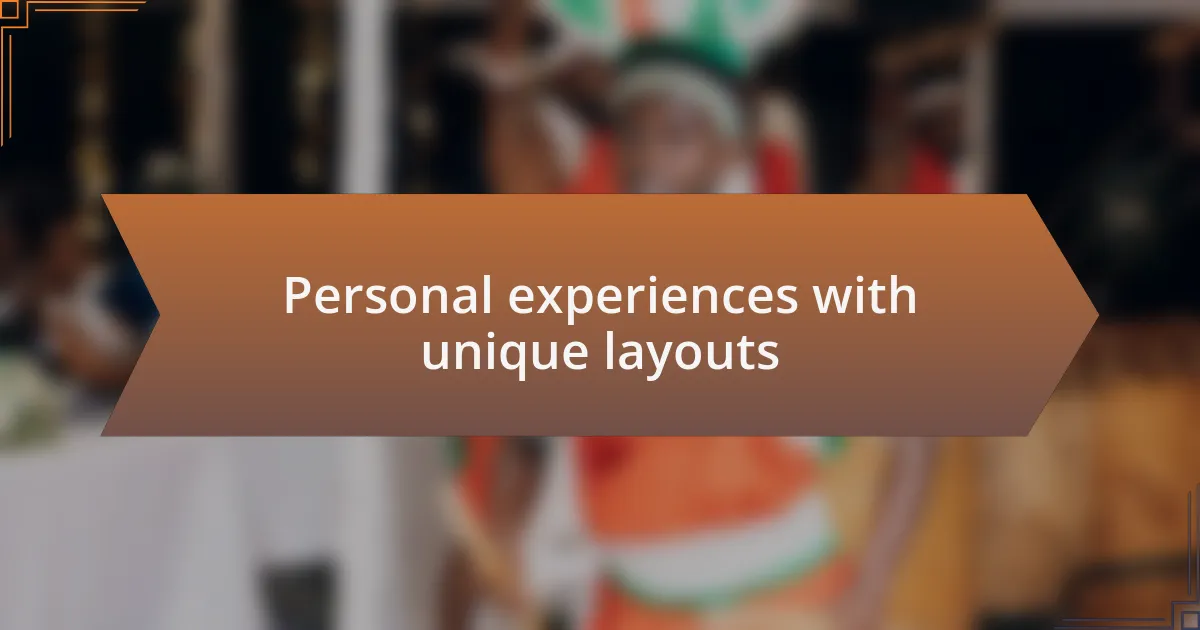
Personal experiences with unique layouts
I remember a gala I organized in an art gallery that had an open layout, filled with stunning sculptures and vibrant wall art. It was breathtaking, yet I noticed guests captivated by the art were often missing out on key presentations. Isn’t it fascinating how a visually stimulating environment can inadvertently distract from the event’s main focus?
One time I managed a multi-day conference in a large tent set up in a park. The layout was sprawling, with sessions held in separate corners, which made navigating from one to another a real challenge. I could feel the attendees’ frustration as they rushed against the clock to reach workshops in time. It made me realize that while unique layouts can create a beautiful atmosphere, they must also support easy movement to enhance the experience for everyone.
During a recent corporate retreat at a historic estate, the unconventional design of the courtyard led to some amazing team-building activities. However, I noticed a few participants hesitating to engage fully due to their unfamiliarity with the space. This experience really hit home for me: even the most picturesque venue layout needs to foster connection and comfort among attendees. How do we ensure that unique settings also invite participation, rather than hold people back?
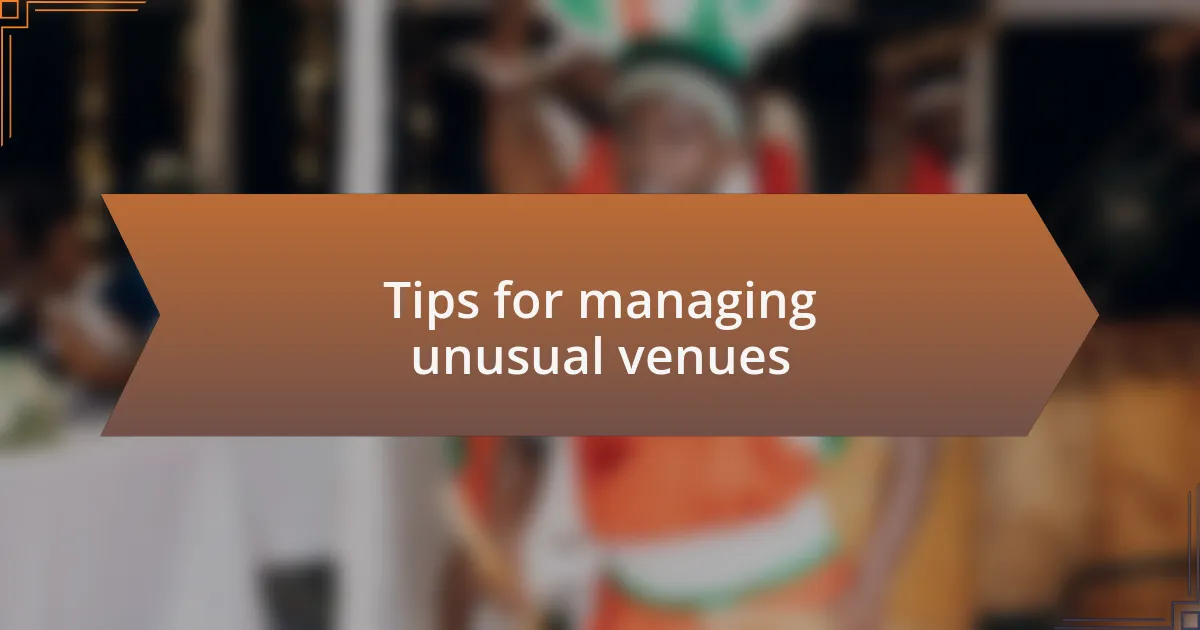
Tips for managing unusual venues
When managing an unusual venue, communication is key. I once coordinated a wedding in a converted warehouse filled with character and charm. However, it required a well-thought-out plan to ensure everyone understood where things were happening. As I navigated that process, I learned that clear signage and even a digital map app can guide guests seamlessly through quirky layouts. Isn’t it surprising what a little thoughtful planning can do to enhance the experience?
In one event, I had to deal with an outdoor venue that was beautifully landscaped but posed significant logistical challenges. Weather unpredictability was a constant worry, and setting up for different activities in various nooks took meticulous organization. I found that preparing contingency options—like covering areas with tents—allowed us to embrace the beauty while mitigating stress. It’s moments like these that teach you the importance of flexibility and foresight.
I once faced a situation where an unusual venue didn’t have enough seating arrangements for a large group, which could easily have turned into chaos. Instead of letting it detract from the event’s enjoyment, I decided to turn the challenge into an opportunity for networking. By facilitating mingling around standing tables, those unexpected interactions created a lively atmosphere. How can we transform potential setbacks into benefits, rather than viewing them as purely obstacles?